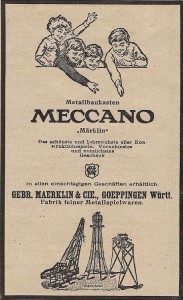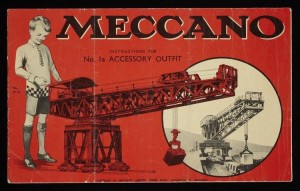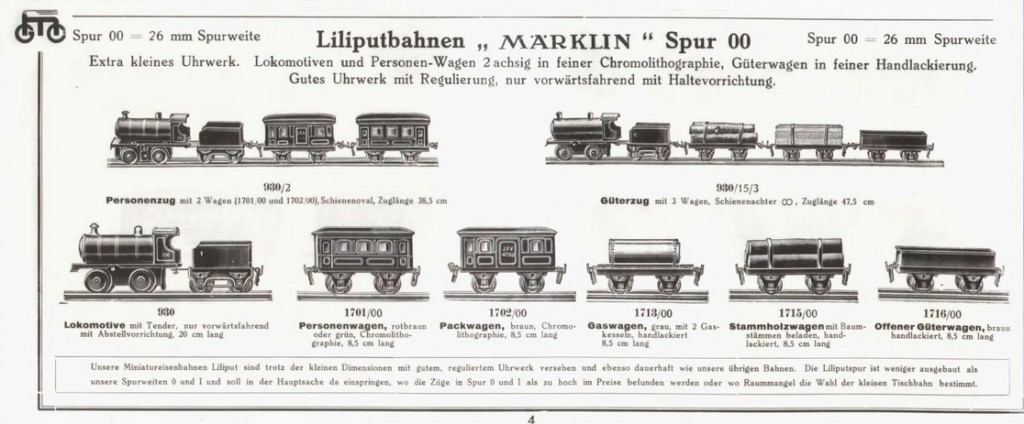Collaboration in the Early Years, 1891 – 1935: RAYLO, Meccano, and Liliput

Frank Hornby of Liverpool, England began tinkering with tin toys in his home workshop and made toys for his sons starting in the 1899. Already by September of 1907, Hornby registered the brand “Meccano” and produced small construction sets with tin parts that could be use to construct various metal sculptures. The initial success of Meccano and the large demand for these construction sets opened up Hornby to an international market with distribution centers and dealers popping up all across Europe.
It is no surprise that the success of Meccano with its construction sets intrigued the long-standing master of tin toys in Europe, Gebr. Märklin & Cie which began producing some Meccano parts and sets under a contractual agreement. Märklin already had vast experience by this time with producing clockwork motors and other accessories for non-train related items and very much enjoyed this partnership. Meccano focused on producing construction sets which it knew very well and Märklin enhanced this produce line with clockwork motors and mechanized systems with gears and electrical plugs and various circuits that enhanced the toys greatly. It is reported that between 1911-1913, Märklin made around 60,000 clockwork motors for the Meccano product lines. Unfortunately at the start of World War One in 1914, the legal protection of trademarks of many foreign companies were relinquished to the German Reich. On the 15th of August 1915, Märklin acquired the trademarks and rights of Meccano in Germany and could continue production on its own of this well-known brand. The tooling used to produce Meccano parts out of tin sheets, however, was for the meantime used during the war for things like belt buckles, shell casings, and other war materials. After the war, production continued as normal as we can see from an advertisement stating the joining of the brand Meccano and Gebr. Maerklin & Cie which in literature would commonly be written as “Meccano-Märklin-Metallbaukasten.”
Despite Märklin’s overtaking of the Meccano brand and the successful integration of it into the Märklin family of finte tin toys, the relationship between Hornby and Märklin was not over. Frank Hornby owned a patent for a miniature railway which he named “RAYLO.” Even years before, Märklin had its eyes on this smaller scale train set from the turn of the century. By 1912 this partnership between RAYLO (under Frank Hornby) and Märklin was solidified and a simple tinplate train of track width 23.5 mm was devised.
Confusing as it may be, the system was named Liliput-Eisenbahn and premiered at the 1914 Leipzig Spring Fair on a beautiful demonstration layout that would later be available only to dealers and important customers. Later, the large layout was released as Number 3830/201 just after WWI in 1919. With some slight interruptions in production, the system was again offered in 1921. Early in 1926, an asterisk in the price list denotes a change in the system. The model number changed from “3830/201” to “13830/201 Z” describing the 20 volt version. In 1930, a small dot in the price list indicated that no more new series were planned, but the layout could still be found in the special price list of 1931. Sold at reduced prices as Ausverkauft (sold-out clearance), the plant remained under the model number “13830/201 Z” up to the year 1934 where it was gradually phased out possibly for the introduction of the true 00 Gauge system in the following year 1935.
Although records about the production of this layout are difficult to find, it is highly likely that the beautiful tinplate buildings offered with the layout were easily produced by the skilled tinsmiths and master artisans at the Märklin factory. Such tinplate stations, goods sheds, and tiny houses and accessories were very similar to O Gauge accessories but were slightly smaller in scale. When the layout first came out in 1914, however, Märklin would have had very little experience with producing trains on such a miniature scale whereas RAYLO would have been much more experienced with the task. This partnership then produced a wonderful miniature layout system: Märklin probably produced the tin buildings and clockwork motors for the trains and the workers at RAYLO focused on the miniature aspects of the model train system like the small track widths and components for the moving train. Later in 1935, Märklin would dominate this market with their introduction of the 00 Scale which combined tinplate housings and Zinc die-cast frames along with a vast array of tinplate accessories to build an impressive miniature railway system, but for now, the construction was very simple and primitive. A similar miniature table railway produced in 1924 by Gebr. Bing is pictured at right.
At once the competition to build the best miniature railway in the early 1900s and the collaboration between firms brought into fruition many wonderful railway systems for the 00 scale (and the similar 23.5 mm track width). The RAYLO system, made of relatively simple construction received great improvements when the engine for this railway was manufactured partly (or completely) by Marklin. The system had mechanical, remote controlled switches that were to be controlled by the operator. The set was thus sold as somewhat of a train game to control the operation of the train. Later, the 00 Scale miniature railway introduced by Marklin would have a design not to dissimilar to its Liliput and RAYLO predecessors.




